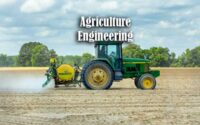Soil Science Questions and Answers
1. Effective rainfall hyetograph is plot of :
(1) Rainfall intensity and time
(2) Rainfall depth and time
(3) Runoff rate and time
(4) Accumulated rainfall and time
2. The maximum size of the raindrop its :
(1) 6 mm
(2) 10 mm
(3) 2 mm
(4) 0.5 mm
3. The double mass curve technique is adopted to :
(1) Check the consistency of rain gauge records
(2) To find the average rainfall over a number of years
(3) To find the number of rain gauge required
(4) To estimate the missing rainfall data
4. Which of the following statement is correct ?
(1) Evaporation from water bodies and soil masses are termed as evapotranspiration.
(2) Evaporation from water bodies and soil masses together with the transpiration from vegetation is termed as evapotranspiration.
(3) Evaporation, interception and depression storage combined together form evapotranspiration.
(4) Evaporation, transpiration and surface runoff are main components of evapotranspiration.
5. An area is classified as a drought prone area if the probability P of occurrence of a drought is :
(1) 04<P< 1.0
(2) 0.2 < P < 0.40
(3) 0.1 < P < 0.20
(4) 0.0 < P < 0.20
6. Base-flow separation is performed :
(1) On a unit hydrograph to get the direct-runoff hydrograph
(2) On a flood hydrograph to obtain the magnitude of effective rainfall
(3) On flood hydrograph to obtain the rainfall hydrograph
(4) On hydrograph if effluent streams only
7. The flood routing by hydrologic method is based on the :
(1) Energy equation
(2) Equation of motion
(3) Equation of continuity
(4) Momentum and continuity equation
8. If time of concentration is more than the rainfall duration then the Rational method will :
(1) Not be able to calculate runoff volume
(2) Not be able to calculate peak runoff rate
(3) Be able to calculate runoff rate
(4) Be able to calculate the peak runoff rate
9. Hydraulic routing method makes use of :
(1) Energy equation only
(2) Continuity equation only
(3) Momentum equation only
(4) Both Continuity and Mementum equations
10. If the duration of unit hydrograph approaches zero, the resulting unit hydrograph is known as –
(1) The limiting unit hydrograph
(2) The threshold unit hydrograph
(3) The instantaneous unit hydrograph
(4) The saturated unit hydrograph
11. Which statement is TRUE about the hydrologic cycle ?
(1) The hydrologic cycle occurs only once each year.
(2) Evaporation is the downward movement of water through the ground.
(3) All the water in our environment recycles itself over and over again.
(4) The moon is the energy source that causes the water to move through the cycle.
12. What type of material is most likely to be transported as suspended load ?
(1) Clay particles
(2) Sand particles
(3) Gravel particles
(4) All of these are equally likely to be transported as suspended load
13. Movement of water as it passes from the ground surface in to soil is called as :
(1) Infiltration
(2) Percolation
(3) Evaporation
(4) Interceptions
14. Evapotranspiration in a crop field surrounded by dry fallow land will be higher than that surrounded by vegetation, due to :
(1) Conduction of heat
(2) Oasis effect
(3) Clothesline effect
(4) Convection of heat
15. How much of the Earth’s water is stored in underground aquifers ?
(1) Less than 1%
(2) About 5%
(3) About 10%
(4) About 20%
16. Who introduced the concept of TUH (Instantaneous Unit Hydrograph) ?
(1) Clark
(2) Nash
(3) Sherman
(4) Bernard
17. In constructing synthetic Hydrograph the information needed is/are –
(1) Time to peak
(2) Peak volume
(3) Length of flow
(4) All of these
18. A unit hydrograph has –
(1) One unit of peak discharge
(2) One unit of time base of direct runs off
(3) One unit of rainfall duration
(4) One unit of direct runoff
19. Soil degradation takes place due to –
(1) Geological erosion
(2) Accelerated erosion
(3) Glacial erosion
(4) Plant erosion
20. A plot of rainfall intensity versus time is called :
(1) Hydrograph
(2) Mass curve
(3) Hyetograph
(4) Isohyets
| MCQs | Quiz |
| GK | Questions and Answers |
21. The initial infiltration rate is at capacity rate if the intensity of rainfall is ;
(1) Less than the average rate of infiltration
(2) Less than infiltration capacity of soil
(3) Equal to or more than the infiltration capacity of soil
(4) None
22. The formula for estimation of evapotranspiration using only temperature and day length is :
(1) Thornthwaite formula
(2) Penman formula
(3) Christiansen formula
(4) Blaney criddle formula
23. Temporary gully control structures are structural measures such as :
(1) Woven-wire
(2) Brushwood and logs
(3) Loose stone and boulder check dams
(4) All of above
24. Materials used for constructing permanent gully control structures are :
(1) Earth material vegetation
(2) Stones and branches of trees
(3) Masonry, reinforce concrete, earth etc.
(4) None of above
25. The natural grassed waterways are generally found in the shape of :
(1) Square
(2) Triangular
(3) Parabolic
(4) Rectangular
26. The object of surveying is to prepare a :
(1) Map
(2) Cross-section
(3) Drawing
(4) Model
27. The length of a link in a chain is :
(1) 20 cm
(2) 30 cm
(3) 35 cm
(4) 40 cm
28. For ranging a line, the number of ranging rods required is ;
(1) At least two
(2) At least three
(3) At least four
(4) At least five
29. The preliminary Inspection of the area to be surveyed is known as
(1) Rough survey
(2) Primary survey
(3) Route survey
(4) Reconnaissance survey
30. The closing error in a closed traverse is adjusted by :
(1) Lenmanns rule
(2) Slide rule
(3) Bowditch’s rule
(4) Simpson’s rule
31. The working edge of the alidade is known as the –
(1) Parallel! Edge
(2) Beveled edge
(3) Parallax edge
(4) Fiducial edge
32. Spirit level in plane table is used for –
(1) Centering
(2) Sighting
(3) Marking north
(4) Leveling
33. A datum surface in leveling is a –
(1) Horizontal surface
(2) Vertical surface
(3) Level surface
(4) None of the above
34. Which of the following method of contouring is most suitable for hilly terrain ?
(1) Direct method
(2) Square method
(3) Cross section method
(4) Tachometric method
35. A relatively permanent point of reference whose elevation is known as :
(1) Reduced level
(2) Bench mark
(3) Level surface
(4) Datum point
36. Doubling the length of the slope increases soil erosion by about :
(1) 1.4 times
(2) 2.0 times
(3) 2.4 times
(4) 3.0 times
37. When the grade and dimensions of a channel are known, the terrace channel Calrying capacity can be calculated from –
(1) Rational method
(2) Cook’s method
(3) Manning’s formula
(4) Thiesson method
38. The height of the graded bunds should not be less than –
(1) 1.00 m
(2) 0.75 m
(3) 0.45 m
(4) 2.00 m
39. Table top bench terraces are suitable for areas of :
(1) High rainfall
(2) Medium rainfall
(3) Low rainfall
(4) Irrespective of total rainfall
40. A typical sand dune has highest steeper slope to leeward side of :
(1) 15 per cent
(2) 33 per cent
(3) 50 per cent
(4) 65 per cent
41. The life of temporary check dam can be expected upto –
(1) 20 years
(2) 15 years
(3) 8 years
(4) 2 years
42. In an area having general slope of 10%, bench terracing is to be done to bring the land under cultivation, 4.5 m width of land 1s sufficient for doing necessary agricultural operations. If risers are to be laid on 1:1 gradient, the vertical interval between two consecutive benches will be :
(1) 0.45 m
(2) 0.50 m
(3) 4.00 m
(4) 1.00 m
43. If depth of water over the crest of a spillway is 45 cm. Assuming (0.45)3/2 = 0,3, the length of the crest of the drop spillway for a discharge of 5.3 m/sec will be :
(1) 0.45 m
(2) 1.77 m
(3) 10.00 m
(4) 5.30 m
44. In a gravity dam of base width “b” the maximum permissible value of eccentricity “e” is :
(1) b/8
(2) b/4
(3) b/6
(4) b/3
45. Soil conservation practices are –
(1) Contour farming and terracing
(2) Strip farming
(3) All of above
(4) None of above
46. Soil erosion is a process of transportation of soil by –
(1) Wind
(2) Water
(3) Glacier
(4) All of the above
47. Forces opposing the soil uplift and entrainment are :
(1) Gravity, friction and cohesion
(2) Wind velocity and particle wt.
(3) Friction and cohesion only
(4) None
48. The design of permanent structures is done based on the return period of :
(1) 5-10 years
(2) 10-20 years
(3) 25-30 years
(4) None of above
49. Soil detachability increases as the :
(1) Size of particles reduces
(2) Size of particles increases
(3) Impact angle of raindrop reduces
(4) Length of slope reduces
50. If the land slope is increased four times, the velocity of water flowing over it will increase :
(1) Three times
(2) Two times
(3) Negligible
(4) Four times

